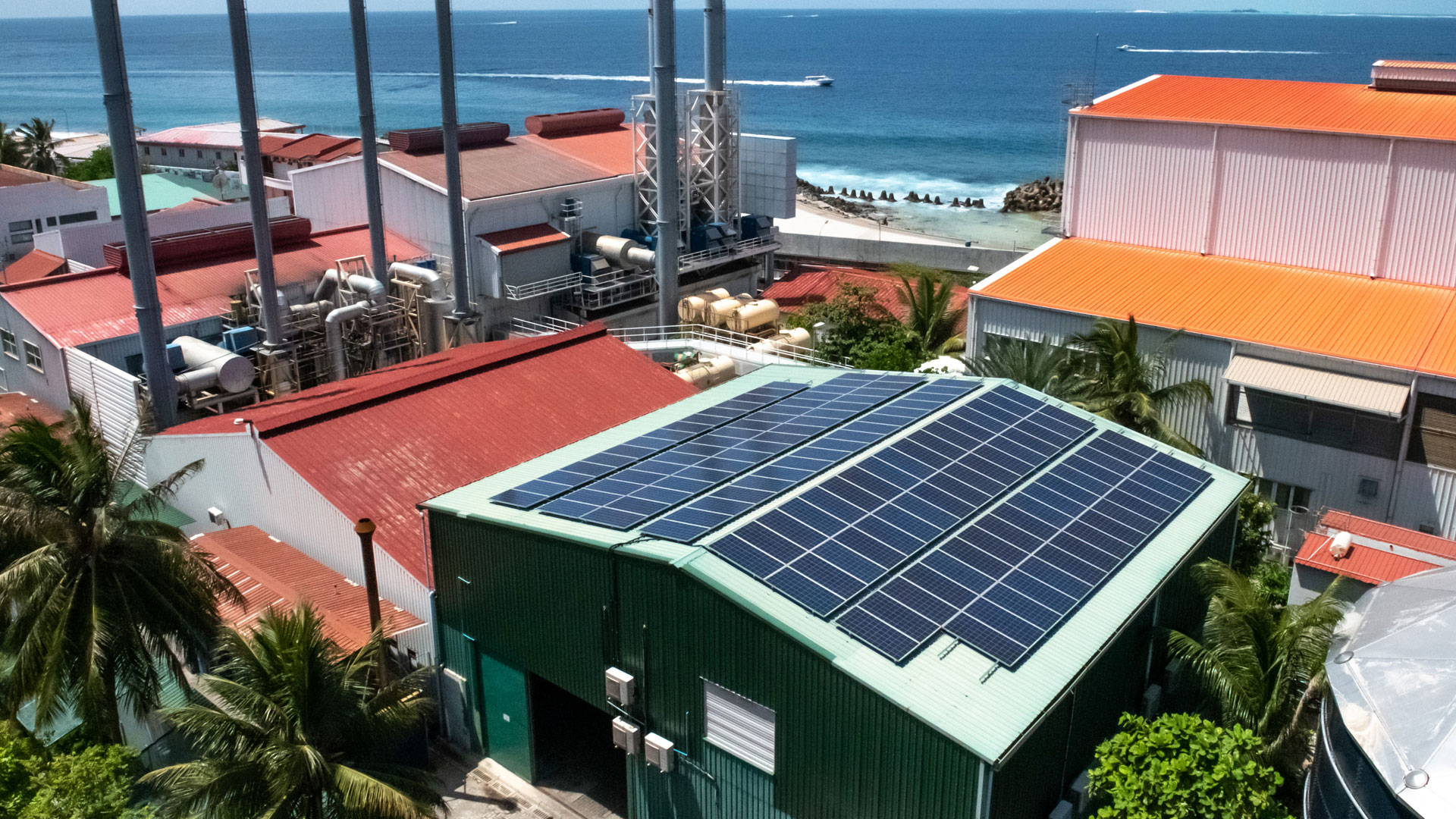Solar Power for a Greener Energy Sector
Scattered across 80 kilometers of the Indian Ocean are the 1,192 islands of the Maldives, only 188 or 16% of which are inhabited. Because the islands are isolated and dispersed, small power systems with limited possibilities for interconnection and expansion were developed. For so long, the country has had to make do with imported diesel to fuel their electricity, which was very expensive and not environment-friendly. About 10% of Maldives’s gross domestic product is spent on fossil fuel imports, mainly for diesel, of which more than 50% is used for power generation.
In 2014, ADB and the Strategic Climate Fund initiated the Preparing Outer Islands for Sustainable Energy Development Project, an initiative that aimed to transform the country’s carbon-intensive electricity supply into a green energy system. Later joined by the European Investment Bank and the Japan Fund for Joint Crediting Mechanism, this investment replaced Maldives’s diesel-fueled electricity grids with a renewable energy–ready grid system. This technology is powered by a solar photovoltaic battery–based hybrid system and boosted with enhanced energy management systems, upgraded distribution grids, and supervisory control and monitoring systems. In 2020, ADB infused additional financing into the project to expand this renewable energy–based hybrid power system to additional outer islands, introduce disaster-resilient components and gender-inclusive livelihood activities to support fisheries, and pilot a transport system run by solar energy.
Greening the Energy System
Installing a renewable energy–based hybrid power system
The project began the installation of one of the largest hybrid renewable energy systems covering many dispersed and vulnerable islands. It started with five pilot islands. The hybrid system is a combination of an efficient diesel generator system, a battery storage system, a solar photovoltaic system, and an energy management system. In 2020, the project successfully installed about 9.5 megawatts (MW) of solar photovoltaic capacity, 5.6 megawatt-hours (MWh) of battery energy storage systems, and 11.6 MW of energy-efficient diesel generators in 70 outer islands across 8 atolls. This has increased Maldives’s renewable energy penetration from 0.1 MW in 2008 to more than 21.5 MW to date.
Enhancing stakeholder capacities
To ensure Maldives’s smooth transition to the green power system, the project supported the government in developing a road map to renewable energy. It has been building the capacity of the Ministry of Environment (MOE) and the electricity utilities—State Electricity Company Limited (STELCO) and FENAKA Corporation Limited—so that they can operate the power systems on their own. It has also supported MOE in developing regulations to approve investment plans and in the operations of project facilities. The project has boosted STELCO’s and FENAKA’s governance by helping them fortify management with independent directors who possess technical, legal, and financial expertise.
Ensuring climate resilience
Nestled in the Indian Ocean at a low elevation and with narrow and dispersed islands, Maldives is highly susceptible to flooding and extreme weather conditions. The additional financing was used to enable the infrastructure to withstand heavy rainfall, extreme wind strengths, and salt from the seas. Through this support, the project assets were designed and situated to avoid the environmental impacts of climate change. It also helped install disaster-resilient distribution networks in one island, which feature smart metering, flow meters for generators, and lightning protection devices.
Scaling up project outputs
The additional financing will expand the coverage of the hybrid power systems and optimize them with grid upgrades, energy management systems, and supervisory control and data acquisition or SCADA systems in 12 additional outer islands. Moreover, it will enable the project to provide fishers with solar photovoltaic–based icemaking machines in four outer islands. This supplemental support will also introduce a renewable energy–operated ferry that can transport 60–70 passengers. Powered by a combination of solar photovoltaic panels and batteries, this pilot transport initiative can be replicated in the nation’s many islands and resorts.
Seeing the Fruits of Renewable Energy
This ongoing project has helped the Maldives make its energy sector green and sustainable. The interventions it introduced are helping reduce the cost of electricity both for the government and the consumers while helping cut carbon emissions. They have also diversified the country’s power generation mix.
The project has already installed hybrid renewable energy systems in 70 of the inhabited islands. It hopes to cover at least 160 when the project closes in 2023. The hybrid power systems it installed have contributed to the gradual reduction of diesel generator usage and, consequently, noise and air pollution. It reduced the country’s carbon emissions in the energy sector by at least 40,000 tons.
More benefits are sure to come in once the project ends. At project completion, Maldives will be powered by 24.5 MW of solar photovoltaic capacity, 9.5 MWh of energy storage, and 20 MW of efficient diesel generator sets. Distribution grids in 160 of its islands will be upgraded, too. Projections also show that electricity tariffs will improve to cover up to 100% of costs at project close, saving the government subsidy costs and allowing it to spend more on other public services.
Cost
$130 million
- ADB $48.5 million
- Government counterpart $14.5 million
Cofinancing Partners
- European Investment Bank (Loan) $50 million
- Japan Fund for the Joint Crediting Mechanism (Grant) $5 million
- Strategic Climate Fund (Grant) $12 million
Dates
Approval Date September 2014
Signing Date December 2014
Completion Date March 2021

